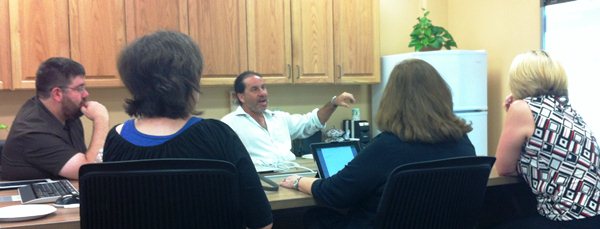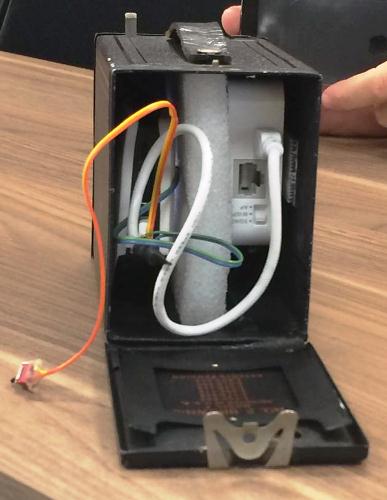At some point, there probably will be a DALMOOC 2.0. I can say that with confidence because we are already having discussions about it. But the timing, format, etc are still a bit fluid right now. However, we (the DALMOOC team, not a royal “we”) have put a lot of time and thought into improvements and redesign. From my end as instructional designer, there are several issues I would like to address. This post really serves as a list for me personally, but might be of interest to others.
Instructivist Layer
- The content later of DALMOOC had a good amount of focus on the facts of Learning Analytics (pedagogy) as well as a good focus on the how to learn about Learning Analytics (heutagogy). There is more discussion on ramping up the heutagogical side of the equation some more, which I think is great.
- Where the design mostly fell flat on this layer was the assessments. They were tied to multiple competencies per week and left a bit open as to how to participants would complete them. We really need to focus on one assessment activity per week (or even every two weeks). This may mean reducing the number of competencies to one per week, or utilizing sub-competencies.
- Additionally, since this is the more guided layer, the one assignment we create probably will need to have more guidance for how to complete it. That is the point of instructivism after all.
Connectivist Layer
- This layer probably suffered the most from not have a good solid “glue” between the layers, so a lot of the re-design will be addressed in “The Glue” section next.
- The assessment/artifact part of this layer also suffered from having so many competencies to complete, so focusing those into one artifact will help immensely.
- The assignment bank was unevenly utilized, and that needs to be fixed. Having more focus on the competencies would help with this, also. The idea would be that the assignment bank gives various scenarios, artifact ideas, or data sources to use when working on artifacts to complete each competency. But what the bank contains could actually be different each week. One week that looks at, say, the history of data analytics could have a bank of ideas how to explain the history (video, paper, interactive timeline, blog posts, etc). The next week that looks at how to perform SNA could have a bank of sample data sets to use. Or a bank of scenarios of where to get data from. Finally, each bank would have a “do your own thing” option to point out to learners that in this layer they can come up with their own ideas.
- Group connections and formation needs a lot of work, but the “Behind the Scenes” section will look at some of that.
The Glue
- The original intention was to have a weekly/daily email that provided a connection point for all participants, as well as stepping out points and scaffolding for people that wanted to try out social learning for the first time. These emails never happened. And we found out that not everyone reads email (shocking, I know). So a new idea is being floated around.
- This idea is to have a centralized website for the class. This website only displays what is being worked on that week (but with a menu to get to older content and the syllabus, of course). Basically, think a blog with a simplified theme that only shows one post at a time. This site intros the competency for the week, with options to choose which layer the participant is interested in. Selecting a layer would display links and instructions for what to do next for that layer (view videos in EdX, create goals in ProSolo, etc.). There would also be a link to a scaffolding area for people that want to try the connectivst layer but need guidance.
- The information on this site would be blasted out to email, Facebook, Twitter, etc. Whatever avenue people want to use to be informed that a new week of the course is posted.
- Finally, this glue site would have a list of people that it recommends for you to connect with, as well as a list of Tweets and Blog Posts that interest you. Hopefully this could be personalized for each user – based on your activity, interests, skill levels, etc. More on that in the “behind the scenes.”
Behind the Scenes
- The biggest changes to make all of this run smoothly need to be programmed behind the scene. For example, the glue site would need to support single sign-on between EdX, ProSolo, WordPress, Google, etc. Once you sign in, any link you click on should take you to something that you are already signed into.
- Ultimately, it would be best to create the possibility for this sign-on could be handled by individual websites, so people can own their work and data for this course.
- A more detailed Profile would be helpful. Using profile data along with course activity/posts/tweets/etc, various programs could recommend specific people for you to connect with, or even specific Tweets or blog posts you might like to read. These algorithms/programs/etc would be working behind the scenes to help find people and content for participants to connect with. At least, for those that choose to opt-in.
- We are also pondering if we need to add better group tools into the glue site to help people with group activities. Or maybe add that to ProSolo. Plug-ins like BuddyPress for WordPress could create all kinds of tools for groups to use, at least for those that don’t want to find their own.
- The teams working on QuickHelper and ProSolo also have some great ideas for improving their tools – but I won’t spill any beans on those because they can explain those ideas better than I can.
The Matrix
- We had an initial course narrative based on The Matrix, but time prevented fuller development of that.
- The red pill/blue pill metaphor seemed to help many understand course structure. We could possibly integrate that into the Glue website. For example, click on the red pill for one layer and the blue pill for the other. Maybe even create a purple pill metaphor for the scaffolding steps between the two.
- Other things could be added – use quotes from the movie to explain things here and there. Add Matrix like graphics to the visual syllabus and videos. Have a distracting moving Matrix background. Someone could dress up as DALMorpheus and talk in riddles. And so on. I did make a mock-up of all of these ideas for a “Glue” website. As a warning, this takes the course narrative to Jim Groom extreme levels – which I love. But others don’t, so don’t expect DALMOOC 2.0 to look anything like this. But if we went full tilt on all of these ideas with the course narrative and glue website, it might look something like this.
![]() So, any thoughts, ideas, suggestions, etc would be greatly appreciated.
So, any thoughts, ideas, suggestions, etc would be greatly appreciated.
(image credit: Flavio Takemoto, obtained from freeimages.com)
Matt is currently an Instructional Designer II at Orbis Education and a Part-Time Instructor at the University of Texas Rio Grande Valley. Previously he worked as a Learning Innovation Researcher with the UT Arlington LINK Research Lab. His work focuses on learning theory, Heutagogy, and learner agency. Matt holds a Ph.D. in Learning Technologies from the University of North Texas, a Master of Education in Educational Technology from UT Brownsville, and a Bachelors of Science in Education from Baylor University. His research interests include instructional design, learning pathways, sociocultural theory, heutagogy, virtual reality, and open networked learning. He has a background in instructional design and teaching at both the secondary and university levels and has been an active blogger and conference presenter. He also enjoys networking and collaborative efforts involving faculty, students, administration, and anyone involved in the education process.


